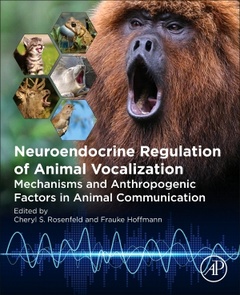Description
Neuroendocrine Regulation of Animal Vocalization
Mechanisms and Anthropogenic Factors in Animal Communication
Coordinators: Rosenfeld Cheryl S., Hoffmann Frauke
Language: English
Subjects for Neuroendocrine Regulation of Animal Vocalization:
424 p. · 21.4x27.6 cm · Paperback
Description
/li>Contents
/li>Readership
/li>Biography
/li>Comment
/li>
Neuroendocrine Regulation of Animal Vocalization: Mechanisms and Anthropogenic Factors in Animal Communication examines the underpinning neuroendocrine (NE) mechanisms that drive animal communication across taxa. Written by international subject experts, the book focuses on the importance of animal communication in survival and reproduction at an individual and species level, and the impact that increased production and accumulation of endocrine-disrupting chemicals (EDCs) can have on these regulatory processes.
This book discusses sound production, perception, processing, and response across a range of animals. This includes insects, fish, bats, birds, nonhuman primates, infant humans, and many others. Some chapters analyze how neuroactive substances, endocrine control, and chemical pollution affect the physiology of the animal?s perceptive and sound-producing organs, as well as their auditory and vocal receptors and pathways. Other chapters address the recent approaches governments have taken to protect against the endocrine disruption of animal (vocal) behaviors. The book is a valuable resource for researchers and advanced students seeking first-rate material on neuroendocrinological effects on animal behavior and communication.
I. Introduction
1. Neuroendocrine control of sound production and perception
II. Sound production and perception
Section A: Invertebrates
2. Acoustic identification of insects based on cepstral data fusion and hidden Markov models 3. Sound production and perception in invertebrates: Regulation of acoustic sensory-to-motor processing in insects 4. Acoustic/vibration behaviors in crustaceans
Section B: Vertebrates
5. Vocal production in anurans 6. Endocrine modulation of acoustic communication: Xenopus laevis as a model system 7. Reptile sound production and perception
Section C: Mammals
8. The role of sex hormones in human language development 9. From whispers to howling cries: Sound production and perception in nonhuman primates 10. Canine sound production, perception, and processing 11. Artiodactyl vocalization 12. Neuroendocrine controls of vocalizations in rodents 13. The perception of acoustic signals and the hormonal control over acoustic communication in rodents 14. Vocalization in subterranean and fossorial rodents 15. Sonic and ultrasonic communication in bats: Acoustics, perception, and production 16. Sound production and propagation in cetaceans 17. Elephant sonic and infrasonic sound production, perception, and processing 18. Marsupial vocal communication: A review of vocal signal production, form, and function
Section D: Birds
19. Neuroendocrine regulation of vocalizations and other sounds in nonsongbirds 20. Courtship vocalizations in nonsongbirds: Auditory and neuroendocrine mechanisms in intersexual communication
III. The biology and politics of a silent spring
21. Endocrine disrupters and potential effects on vocalization: Behaviors in rodents and other species 22. Measures to curb endocrine-disrupting chemicals in the United States
Section E: Current steps other countries are taking to minimize exposure of wildlife (and humans) to EDCs
23. Assessment of endocrine disrupters under European regulations 24. Assessment strategies of endocrine disrupters under regulations of the ministry of the environment of Japan 25. Africa 26. Final thoughts on understanding animal vocalizations in the 21st century
Frauke Hoffmann received her Dr. rer. nat. in 2012 at the Humboldt University of Berlin and the Leibniz-Institute of Freshwater Ecology and Inland Fisheries, focusing on animal communication and EDC effects on vocalizations. She is currently a senior scientific officer at the German Federal Institute for Risk Assessment.
- Serves as the most comprehensive cross-taxa study of its kind, revolutionary in its focus on the impacts of EDCs on the processes guiding animal communication
- Emphasizes the importance of production, perception and processing of acoustic vocalization for survival
- Analyzes recent governmental policies and protections against the effects of EDCs on humans and wildlife
These books may interest you

Primate Vocal Communication 179.34 €

Sound Communication in Fishes 158.24 €


